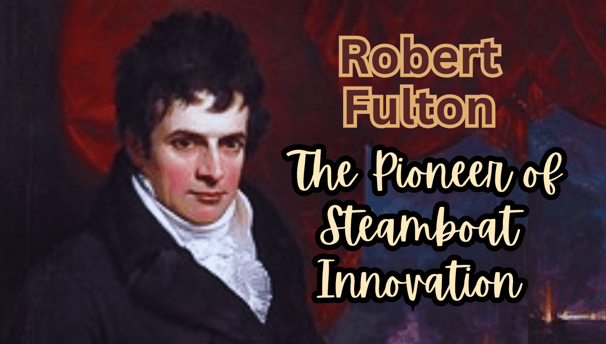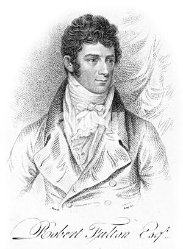Robert Fulton: The Pioneer of Steamboat Innovation and Early Naval Engineering
Robert Fulton (November 14, 1765 – February 24, 1815) was an influential American engineer and inventor, celebrated for his groundbreaking work in steam-powered navigation. He is widely credited with developing the world's first commercially successful steamboat, the North River Steamboat (commonly known as Clermont), which revolutionized trade and transportation on American rivers. Fulton's innovative ventures spanned a variety of fields, including naval engineering, where he contributed to submarine design and naval weaponry.
Casey Adams
2/13/20257 min read


Early Life and Education:
Foundations of Ingenuity
Robert Fulton was born on November 14, 1765, on a farm in Little Britain, Pennsylvania, a rural community in Lancaster County.
He was the third of five children born to Robert Fulton Sr., an Irish immigrant and modest farmer, and Mary Smith, the daughter of Captain Joseph Smith and sister of Colonel Lester Smith, a relatively affluent family with connections to local military and civic leadership.
Fulton’s siblings included three sisters—Isabella, Elizabeth, and Mary—and a younger brother, Abraham.
The family’s modest circumstances and rural setting shaped Fulton’s early life, fostering a self-reliant and resourceful character.
Fulton’s formal education was limited, likely confined to a local schoolhouse where he learned basic reading, writing, and arithmetic.
However, his intellectual curiosity and mechanical aptitude emerged early, fueled by the practical challenges of farm life and exposure to mechanical devices like plows and mills.
At around age 12, in 1777, Fulton experienced a transformative encounter that would define his future.
He visited William Henry, a prominent Lancaster delegate and early American inventor, who had been inspired by James Watt’s steam engine during a visit to England.
Henry’s experiments with steam technology captivated the young Fulton, igniting a lifelong fascination with steam power and its potential applications.
As a teenager, Fulton moved to Philadelphia, a bustling center of commerce, culture, and innovation, where he sought to develop his skills and support his family.
For six years, he worked as a portrait painter and draughtsman, apprenticing under established artists and craftsmen.
His artistic talents allowed him to earn a modest income, which he used to help his mother and siblings.
This period was formative, exposing Fulton to Philadelphia’s vibrant intellectual community, influenced by Enlightenment ideals and scientific inquiry.
His artistic precision and mechanical drawings of houses and machinery foreshadowed his later engineering achievements.
In 1785, at the age of 20, Fulton purchased a farm in Hopewell Township, Washington County, near Pittsburgh, for £80 (equivalent to approximately $13,638 in 2018 dollars).
He relocated his mother and family to the property, demonstrating his commitment to their welfare and his entrepreneurial spirit.
This move also positioned him closer to the frontier, where the challenges of transportation and trade would later inspire his steamboat innovations.
Career Beginnings and European Ventures:
A Global Perspective
Fulton’s early career was marked by a blend of artistic and engineering pursuits, reflecting his diverse talents and ambitions.
In 1786, he traveled to England, seeking to expand his opportunities as both an artist and an inventor.
England, at the forefront of the Industrial Revolution, offered unparalleled access to technological advancements and intellectual networks.
Fulton initially studied portrait painting under Benjamin West, a renowned American artist living in London, but his interests quickly shifted toward engineering, inspired by the industrial innovations he observed.
Fulton’s collaboration with Francis Egerton, the Duke of Bridgewater, was a pivotal moment.
The Duke, a pioneer in canal development, was instrumental in expanding England’s inland waterway systems, critical to the Industrial Revolution.
Fulton immersed himself in canal engineering, designing innovative locks, aqueducts, and inclined planes.
His ideas challenged conventional methods, advocating for mechanical propulsion in canal boats—a precursor to his later steamboat designs.
In 1793, Fulton published A Treatise on the Improvement of Canal Navigation, a seminal work proposing revolutionary concepts for canal systems.
The treatise suggested using inclined planes instead of traditional locks to reduce water loss and improve efficiency and explored the potential of steam-powered boats for inland navigation.
While the work garnered attention from engineers and industrialists, it was not immediately adopted, reflecting the conservative nature of the era’s engineering establishment.
Nevertheless, it established Fulton as a serious thinker in civil engineering and foreshadowed his later breakthroughs.
Fulton’s European sojourn extended to France in 1797, where he engaged with leading scientists and engineers, further refining his ideas on steam power and naval technology.
His time in Europe, spanning over two decades, was a crucible for his intellectual and professional development, equipping him with the knowledge and networks necessary for his later innovations.
Naval Innovation:
Submarines and Torpedoes
Fulton’s move to France coincided with the Napoleonic Wars, a period of intense naval competition between France and Britain.
In 1800, Napoleon Bonaparte, recognizing Fulton’s engineering prowess, commissioned him to design a submarine capable of challenging British naval supremacy.
This project resulted in the Nautilus, widely regarded as the first practical submarine in history.
The Nautilus was a marvel of early engineering, featuring a copper-covered wooden hull, a collapsible mast and sail for surface propulsion, and a hand-cranked propeller for underwater movement.
Fulton incorporated innovative features, such as a rudimentary ballast system for submersion and a periscope-like device for navigation.
In 1801, he conducted successful trials in the Seine River, demonstrating the submarine’s ability to submerge, maneuver, and deploy explosives against mock targets.
Despite these achievements, the French Navy declined to adopt the Nautilus, citing concerns over its practicality and the ethical implications of underwater warfare.
Undeterred, Fulton continued to innovate in naval technology.
He developed early naval torpedoes—explosive devices designed to be deployed against enemy ships—proposing their use in conjunction with submarines.
His torpedo designs attracted the attention of the British Royal Navy, which, despite initial skepticism, recognized their potential.
Although his naval innovations were not fully realized during his lifetime, they laid critical groundwork for future developments in underwater warfare and naval engineering.
Fulton’s work on submarines and torpedoes reflected his ability to think beyond conventional warfare, envisioning technologies that could disrupt established military paradigms.
His contributions to naval innovation, though overshadowed by his later steamboat achievements, underscored his versatility as an inventor and his willingness to tackle complex, high-stakes challenges.
The Steamboat Revolution:
Transforming American Transportation
Fulton’s most enduring legacy emerged in 1807 with the launch of the North River Steamboat, popularly known as the Clermont.
This vessel, powered by a Watt steam engine adapted for maritime use, completed a historic 300-nautical-mile (560-kilometer) round trip between New York City and Albany along the Hudson River in just 62 hours—a feat that astonished observers and marked the first commercially successful application of steam power in river navigation.
The Clermont was not the first steamboat—earlier experiments by inventors like John Fitch and James Rumsey had demonstrated the potential of steam propulsion—but Fulton’s design was the first to achieve commercial viability.
His partnership with Robert R. Livingston, a prominent New York politician and diplomat, secured a monopoly on steamboat navigation in New York waters, providing the financial and legal backing necessary for success.
The Clermont’s success was a watershed moment, revolutionizing transportation in the United States by reducing travel time and costs for goods and passengers.
Fulton’s steamboats transformed the American economy, particularly in the burgeoning markets along major rivers such as the Hudson, Mississippi, and Ohio.
They facilitated the rapid movement of agricultural goods, raw materials, and manufactured products, catalyzing the growth of cities and fostering economic integration across regions.
The steamboat era also spurred infrastructure development, including the construction of docks, warehouses, and canals, laying the foundation for America’s industrialization.
Fulton’s innovation extended beyond the Clermont.
He designed subsequent steamboats with improved engines and hull designs, enhancing their efficiency and reliability.
His work not only revolutionized river navigation but also inspired global advancements in steam-powered transportation, influencing the development of railroads and ocean liners in the decades that followed.
Legacy in American Innovation
Robert Fulton’s contributions transcended his steamboat innovations, encompassing a wide range of engineering achievements.
His early work on canal systems and naval technology demonstrated his versatility and foresight, while his steamboats catalyzed America’s transition into the Industrial Age.
By harnessing steam power for practical applications, Fulton bridged the gap between theoretical science and commercial utility, embodying the spirit of innovation that defined the early 19th century.
Fulton’s steamboats had a profound impact on domestic trade networks, enabling the rapid expansion of commerce and settlement in the American interior.
They played a critical role in the westward expansion, connecting frontier regions with eastern markets and fostering economic interdependence.
His innovations also had cultural implications, as steamboats became symbols of progress and modernity, capturing the imagination of a nation eager to assert its technological prowess.
Despite his untimely death at the age of 49 on February 24, 1815, likely from pneumonia, Fulton’s legacy endured.
His engineering advancements inspired generations of inventors and engineers, shaping the trajectory of transportation technology throughout the 19th century.
His work laid the groundwork for subsequent innovations, including steam locomotives and steamships, which further transformed global trade and mobility.
Personal Life and Recognition
In 1808, Fulton married Harriet Livingston, the niece of his business partner, Robert R. Livingston.
The marriage strengthened Fulton’s ties to New York’s political and social elite, providing him with additional resources and influence.
Together, they had four children, though Fulton’s demanding career often kept him away from his family.
Fulton’s legacy is honored in numerous ways.
Fulton County in several U.S. states, including New York, Pennsylvania, and Georgia, bears his name, reflecting his widespread impact.
His achievements are celebrated in museums and historical sites, such as the Hudson River Museum and the Smithsonian Institution, which preserve artifacts and documents related to his work.
He remains a prominent figure in discussions of the Industrial Revolution, often cited as a pioneer of steam-powered transportation.
Conclusion
Robert Fulton’s life and achievements reflect the intersection of art, science, and engineering in an era of profound change.
From his humble beginnings in rural Pennsylvania to his groundbreaking innovations in steam navigation, Fulton’s career embodies the spirit of the American Enlightenment—a belief in progress through reason, experimentation, and innovation.
His contributions not only shaped the economic and technological landscape of the United States but also left an indelible mark on global transportation history.
Though often overshadowed by later industrial giants, Fulton’s legacy endures as a cornerstone of American ingenuity, inspiring continued exploration and innovation in the fields he pioneered.
Robert Fulton



